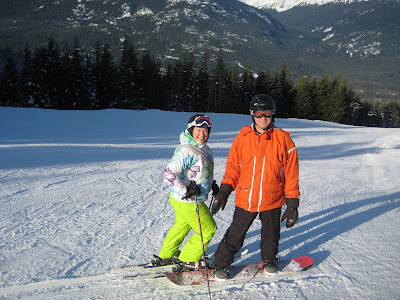Finding balance in skiing can be as elusive as finding it in life. It is especially challenging at the beginning of the ski season. Yet balance is the foundation of good skiing.
A wise man (okay, a race coach) once said balance is any position you are in if you have not fallen. While a little tongue in cheek, the point he was making is that balance in skiing is achieved by being in a constant state of motion. As a skier makes their way down the hill the platform under their skis is constantly changing due to incline, snow texture, bumps, depressions, and so on. If you are static (i.e., not in the process of either bending or extending your legs) you will get the sensation of the terrain skiing you rather than the other way around.
Here are some simple drills I find helpful to get in balance, particularly at the beginning of the season.
1) “Shmeered turns”. Try not to carve your first day or two back on snow. Instead focus on using lots of movement in your hips, knees, and ankles to make round turns down the hill. With carving skis, one can easily apply an edge while being out of balance but it is impossible to execute round turns out of balance.
2) Feel your feet in your boots. Where are you feeling pressure on your feet (shins, heels, inside, outside)? Where in the turn are you feeling it? Try feeling as though your feet are flat on the bottoms of your boots – as though you are balanced on the binding – throughout the turn.
3) Try skiing with your toes up throughout the turn. This forces you to balance over the ball of your foot.
4) For more advanced skiers use inside ski turns where you start each turn skiing only on your inside ski, adding your outside ski after you turn out of the fall line.
5) Also for advanced skiers, use delay turns where you pivot into the fall line, take the time to balance over your skis, then pick up the edge to complete the turn.
Above all, be patient. Your balance will return with some mileage. This is the time of the season to focus on the fundamentals. With strong balance as your base you will be able to take on new ski challenges throughout the season.
On a personal note, I have made a huge leap forward in achieving some balance in my life. I have made the permanent move to Whistler where I will run my media consulting business while skiing and instructing as much as I can. :)
A wise man (okay, a race coach) once said balance is any position you are in if you have not fallen. While a little tongue in cheek, the point he was making is that balance in skiing is achieved by being in a constant state of motion. As a skier makes their way down the hill the platform under their skis is constantly changing due to incline, snow texture, bumps, depressions, and so on. If you are static (i.e., not in the process of either bending or extending your legs) you will get the sensation of the terrain skiing you rather than the other way around.
Here are some simple drills I find helpful to get in balance, particularly at the beginning of the season.
1) “Shmeered turns”. Try not to carve your first day or two back on snow. Instead focus on using lots of movement in your hips, knees, and ankles to make round turns down the hill. With carving skis, one can easily apply an edge while being out of balance but it is impossible to execute round turns out of balance.
2) Feel your feet in your boots. Where are you feeling pressure on your feet (shins, heels, inside, outside)? Where in the turn are you feeling it? Try feeling as though your feet are flat on the bottoms of your boots – as though you are balanced on the binding – throughout the turn.
3) Try skiing with your toes up throughout the turn. This forces you to balance over the ball of your foot.
4) For more advanced skiers use inside ski turns where you start each turn skiing only on your inside ski, adding your outside ski after you turn out of the fall line.
5) Also for advanced skiers, use delay turns where you pivot into the fall line, take the time to balance over your skis, then pick up the edge to complete the turn.
Above all, be patient. Your balance will return with some mileage. This is the time of the season to focus on the fundamentals. With strong balance as your base you will be able to take on new ski challenges throughout the season.
On a personal note, I have made a huge leap forward in achieving some balance in my life. I have made the permanent move to Whistler where I will run my media consulting business while skiing and instructing as much as I can. :)
